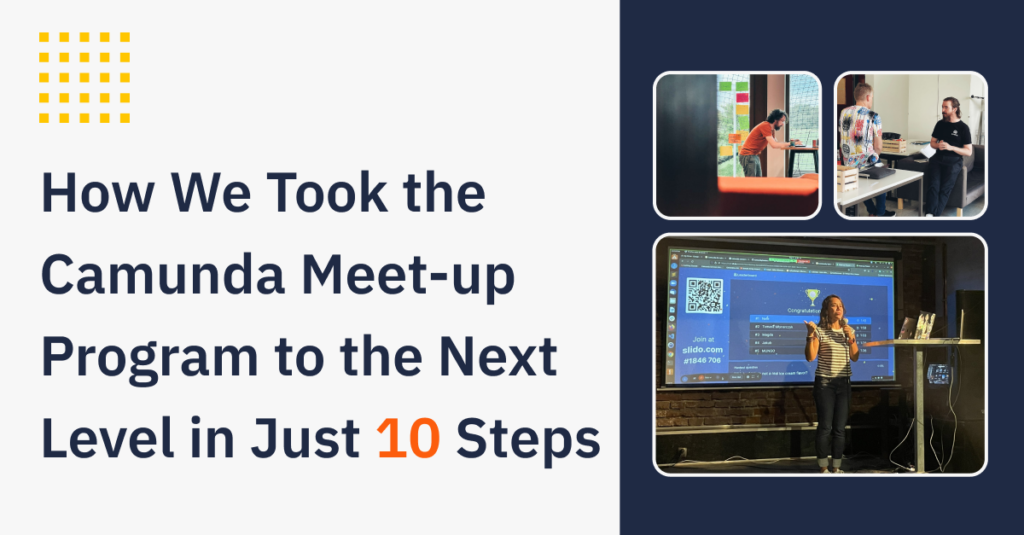The goal of our Developer Relations team at Camunda is to create positive interactions for community members through our products and technical resources, community programs, and platforms, and opportunities to collaborate with other Camunda community members. We achieve this by providing high-quality resources through our platforms and programs. One of them is the Camunda meet-up program. In a nutshell, the program is designed to bring like-minded folks together to talk about something they have a passion for around process orchestration and Camunda! The program is also designed to help organizers (Camunda Chapter Leaders) create a safe space to share and learn together.
There are many great resources out there talking about how to start a user group or meet-up program, like one written a couple of years ago by my colleague, community manager Luca Buchholz: “Six Tips for building a global Meet-up Organizers Program.” This article is for those of you who are looking for suggestions on how to level up your program.
How did it all start?
Back in 2018, some user groups started to appear spontaneously, and Camunda decided to launch a program to support them formally. Many of the actions of this phase were directed at raising awareness throughout the community, letting them know this was something they could do, and helping them to start their own chapters.
As the community continued to grow and new programs were developed, it became clear that another community manager was needed. That is when I came into the picture; I joined in the summer of 2021 to focus primarily on the meet-up program.
Challenges and objectives
These were the challenges I discovered:
- The information and resources for Chapter leaders were scattered.
- Not all processes were documented.
- 41% of the Chapters were inactive.
With this in mind, the 2022 objectives became very clear:

Here are the steps I took to take the meet-up program to the next level.
1. Audit your groups
I had one-on-one calls with all the Chapter leaders with two purposes: to establish a personal connection with them and have a better understanding of their Chapters. These are some of the questions I wanted to clear during our conversations:
- What drives them?
- What language do they prefer to host meet-ups in?
- What are their pain points?
- Do they prefer online, in-person, or hybrid meet-ups?
- Who are the more enthusiastic leaders?
- How often do they like to host meet-ups?
The information gathered was then added to an internal database so anyone from the Developer Relation team could access it.
2. Define key indicators
I was very selective and avoided vanity metrics. They may look impressive but can be misleading and often are not giving us helpful information to either improve the program or measure engagement. I was especially interested in measuring the engagement of the chapters through a couple of objective indicators. Knowing how useful the new resources and support provided to the Leaders was also key, but because this is more subjective, I opted to extract this information from our yearly Community programs feedback survey.
Objective indicators
- <5% of inactive groups by the end of 2022.
- Every active group is hosting two events per year.
Subjective indicators
- Improve perceived satisfaction level of support provided.
- Improve perceived satisfaction level of information provided.
3. Define and document processes
Defining and documenting all processes had many advantages and was a good way to ensure everything ran smoothly. Not only was it easier to make quick changes, but it also meant that everyone involved knew what was happening and could revisit the documentation in the future. This was especially helpful in the decision making process, since I knew I was taking the right steps most efficiently. Additionally, it helped me map the Chapter Leaders journey from beginning to end. Creating their life cycle became key to ensure all leaders were having a good experience in every phase. It was a good way to make sure everyone had the same expectations and understanding of the program and map their happy path. The happy path of each phase is the ideal sequence of events towards what you consider success.
Below is an example of the reactivation phase; in this case success is helping them set up their next meet-up:
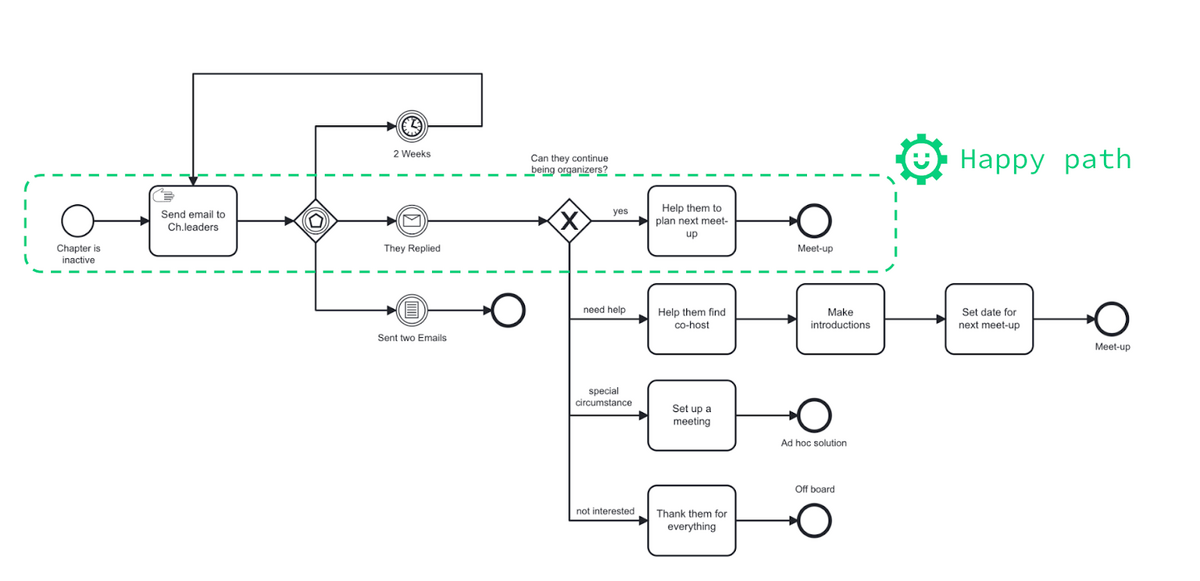
4. Create resources
Awareness resources
These are all the resources that help the community know more about the program. We upgraded the information on our website section letting people know how to start a Camunda Chapter, and added a form for people to apply to become a Chapter Leader.
Enabling resources
These are all the resources specifically created for Chapter leaders. My goal was to create something like “one ring to rule them all” but in the community manager version: one resource to find it all!
With this in mind, the Chapter Leaders Playbook was born. This playbook has all the information needed to run a meet-up. It has topics catering to newbies and experienced organizers. Some of its most important characteristics are:
- One platform to keep all resources relevant for Chapter leaders
- Easy to look for information
- Easy to keep updated
Other benefits of having a single resource where all documentation and resources live include: increased autonomy of Chapter Leaders, you lower the chances of becoming a bottleneck during their activities, and you ensure transparency by giving all Leaders access to information, including the Developer Relations team.
This resource doesn’t mean I am not available for questions or support, I might just not be the first place to look for answers. To keep the relationship with each Chapter strong, I have other touch points with them throughout the year. For example, after a meet-up I reach out to ask how everything went. If a Camundi attended their event, I’ll ask them for feedback and share the impressions with them.
5. Is the platform you use to publish your events working for you or against you?
A quick way of knowing if you have the right platform is whether you can answer yes to most or all of these questions:
- Is it showing all events and chapters at a single glance?
- Can you know the demographics of your attendees?
- Can you follow up on attendance rates?
- Can you integrate it with other tools like HubSpot or CommonRoom?
- Can you demonstrate the impact your program has on the business?
We launched the new Camunda meet-ups page in September 2021. Bevy, the new platform, allows us to answer yes to all of these questions. The user experience is good for Chapter Leaders and administrators. The dashboard provides useful insights such as platform memberships vs. chapter memberships, memberships’ regional distribution, and virtual engagements, amongst others. The migration hasn’t always been an easy ride, but we are very satisfied with its capabilities and user experience.
6. Talk about the program internally
Talking about the program internally is a great way to find allies that can be laying in plain sight. Partner managers, sales managers, and product managers can often help you out by giving talks, inviting people from their network, or introducing folks that have the potential to become great Chapter Leaders.
It’s important to be mindful of these interactions and state clearly:
- Why is it relevant for them to team up with you? AKA, what’s in it for them?
- What is a meet-up, and what is not? Spoiler alert: it’s not a sales or demand-generation event.
- Meet-up etiquette.
These things might be clear to you, but not all roles are familiar with the meet-up format.
7. Outstanding Developer Advocate team
The Developer Advocates are the experts, they have infinite imagination to present recurrent themes, and they thrive when they interact with the community. They are definitely one of the secret ingredients of our Community Programs.
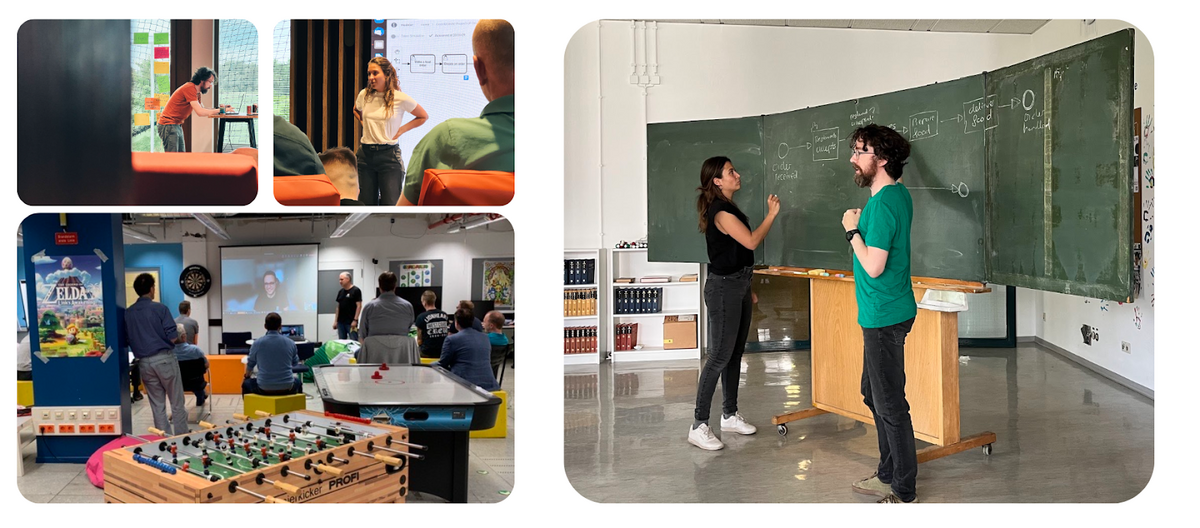
8. Participate in the meet-ups
If you are anything like me, you might enjoy being behind the scenes and enabling others to succeed. However, I encourage you to step out of your comfort zone and participate actively in the meet-ups.
I normally try to participate in a Chapter’s first event to welcome everyone into the Camunda Community and organize a themed trivia of the city we are in. Fun fact, I don’t like participating in trivia because my mind goes blank, but weirdly enough, I love to organize them! Did you know that the clip is a Polish invention or that Berlin has more bridges than Venice? True facts.
You might decide to go with something other than trivia; the important thing is that you feel comfortable and authentic with it.
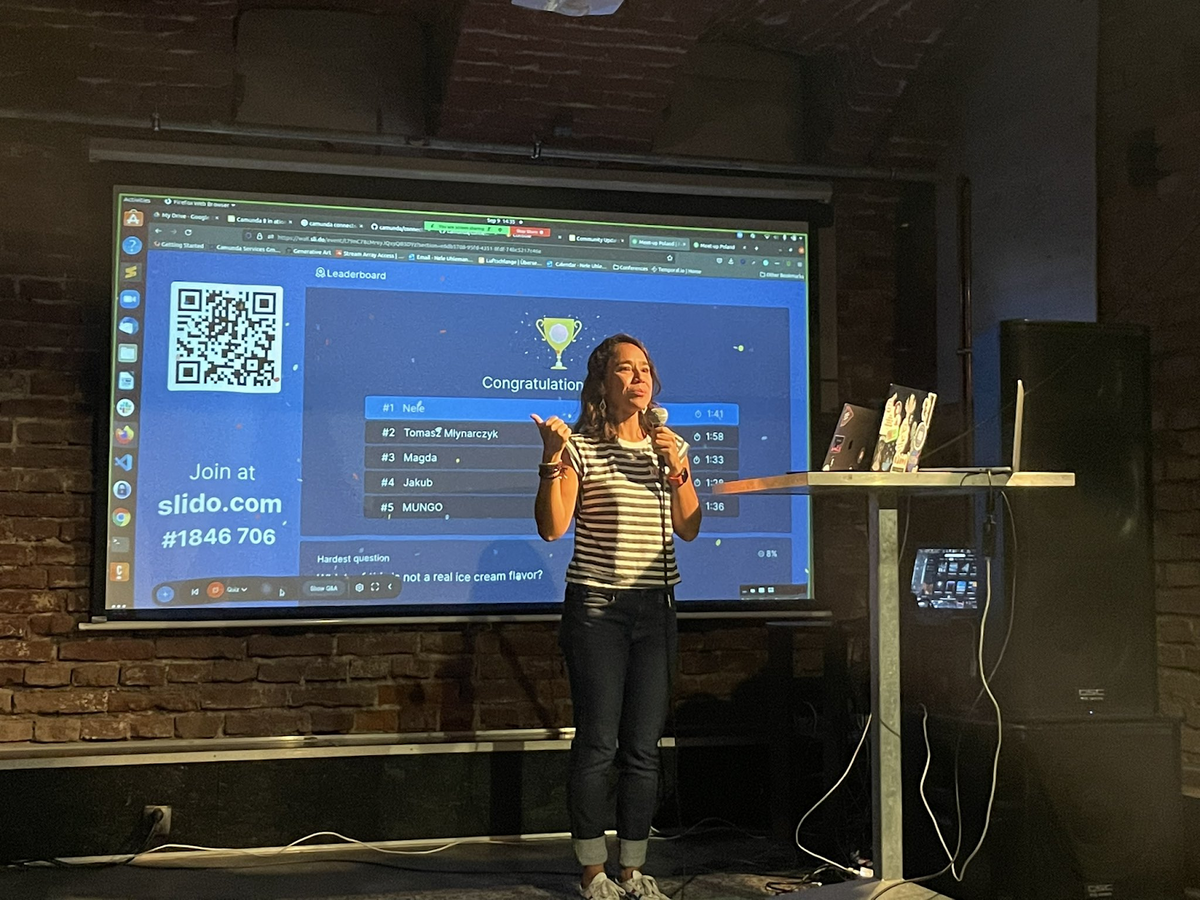
9. Passionate Chapter Leaders
Without passionate people willing to step into the role, this program would not exist. Everything we create must serve them and the space they create within their communities.
Chapter Leaders become ambassadors of our organization, and we want to ensure they have all the resources and knowledge needed to effectively organize meet-ups worldwide.
Camunda Chapter Leaders are some of the most active members of the Camunda Community. They bring together like-minded people by establishing regular meet-ups to discuss the industry’s latest developments, including Camunda’s product contributions. A shoutout to all of them and the amazing work they do!
10. Core skills
Many articles talk about the core skills for folks running programs like this: The soft skills every community manager needs by CommonRoom. I can tell you which skills I’ve found myself leaning into more frequently. Whenever I have a meeting with a Chapter Leader, I try to be fully present. It sounds clichéd, but it makes a big difference in the quality of the conversation and the notes that come out of the session. I try to be perseverant with a good dose of patience to avoid getting discouraged whenever an answer takes longer than I had anticipated. It’s hard to catch people’s attention, but a dose of creativity and humor can go a long way. Don’t be afraid to bring your whole self into the conversation!
Was it a tough year? You bet! Was it worth it? Absolutely! This is how we closed the year compared to the initial objectives:
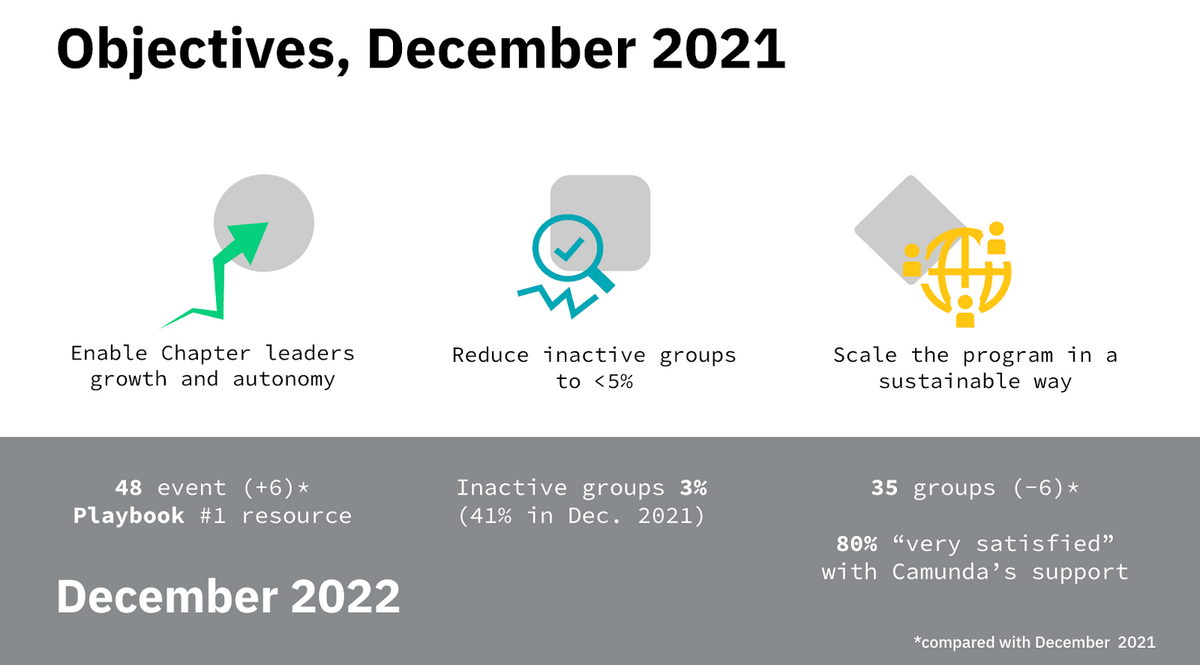
I hope you found something new in this article and that you create something extraordinary for your program. We will continue to evolve the Camunda meet-up program to keep serving our fantastic community to the best of our abilities!
